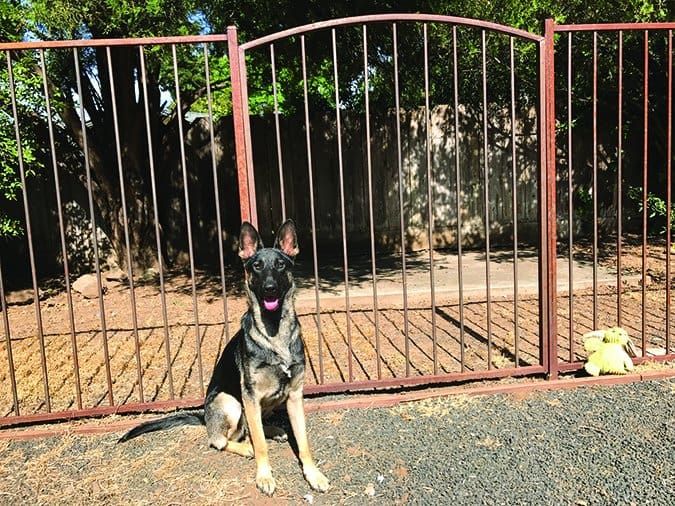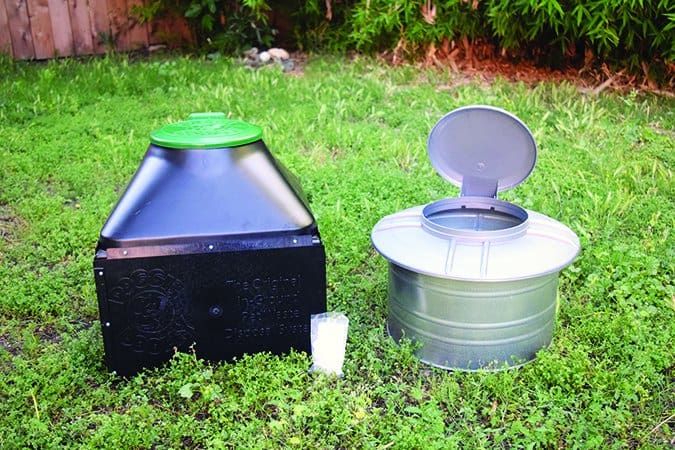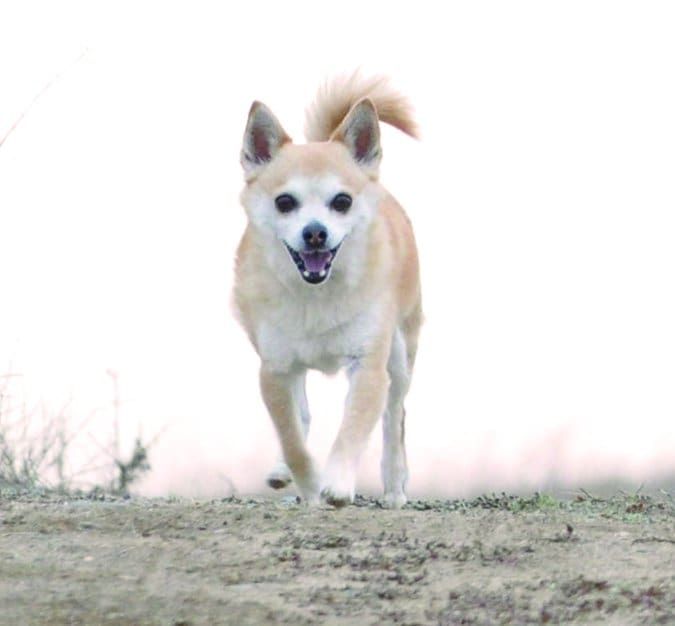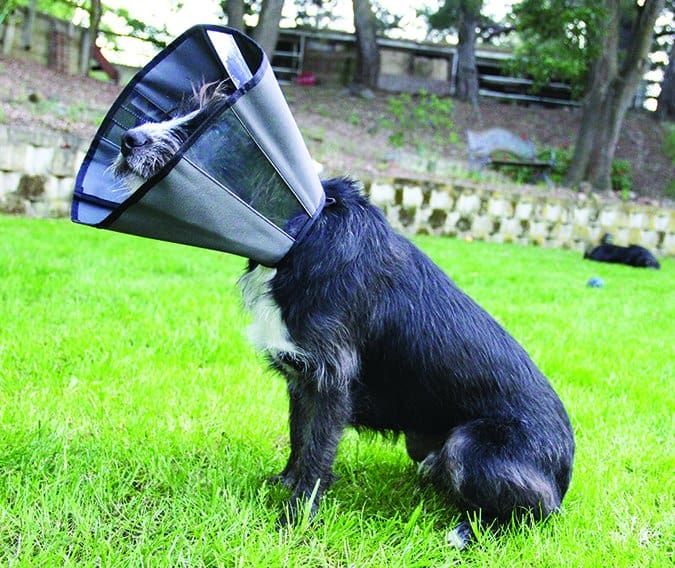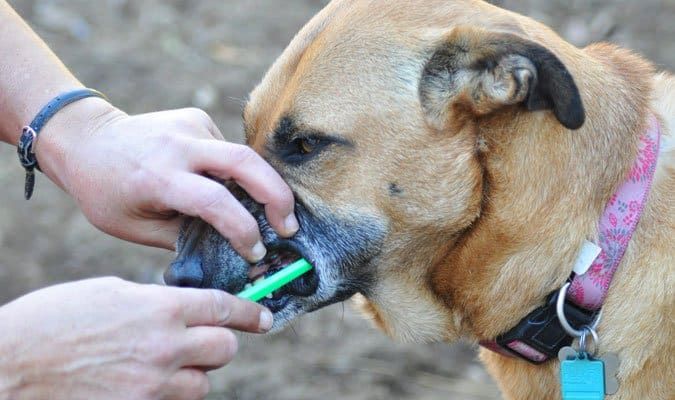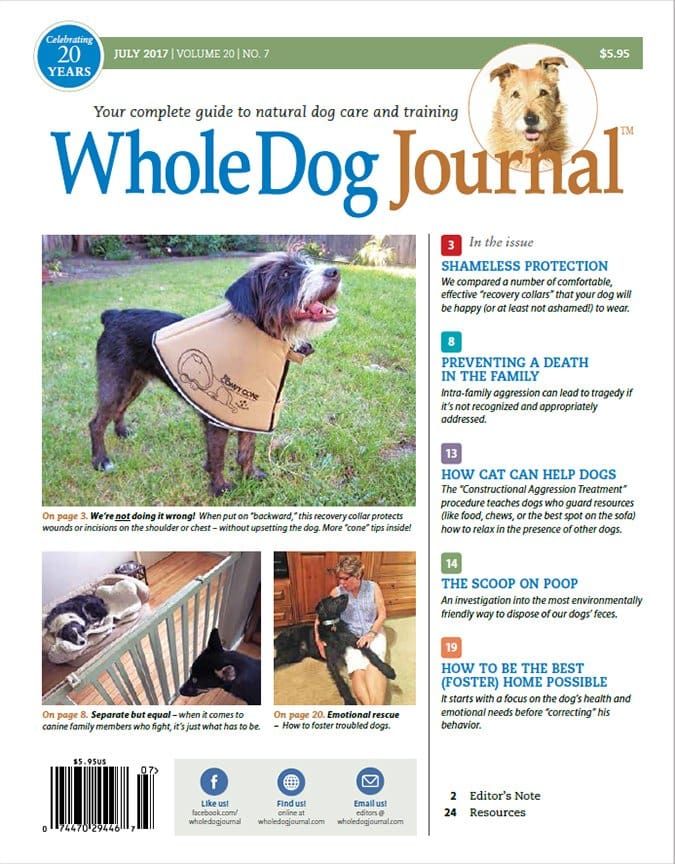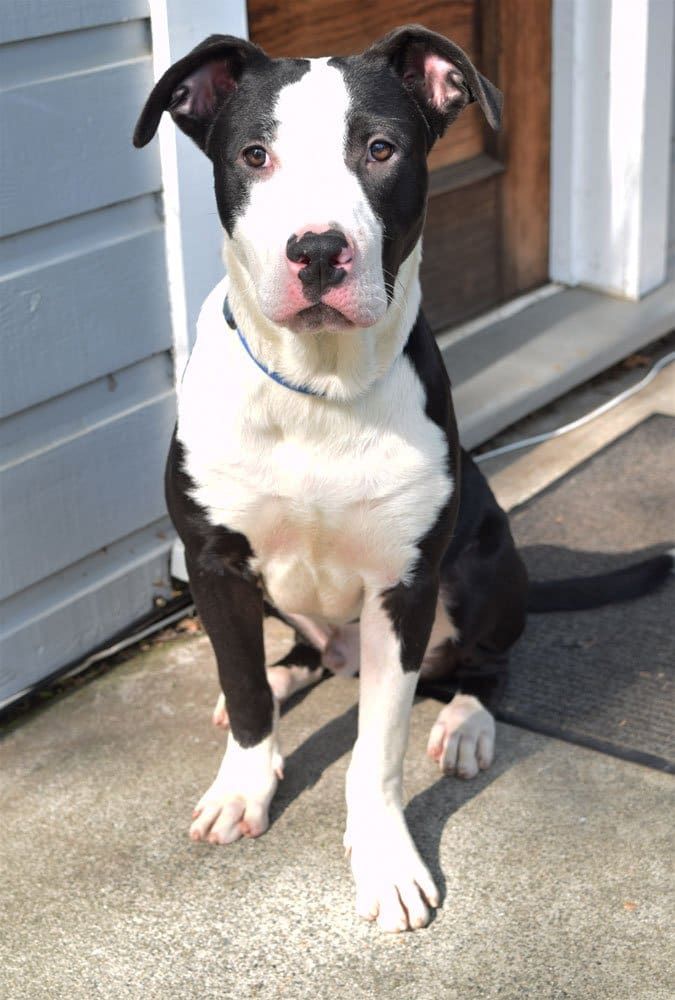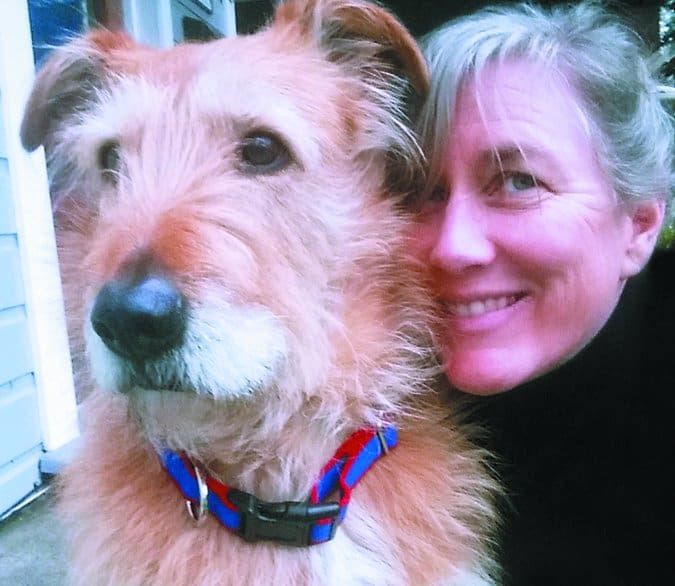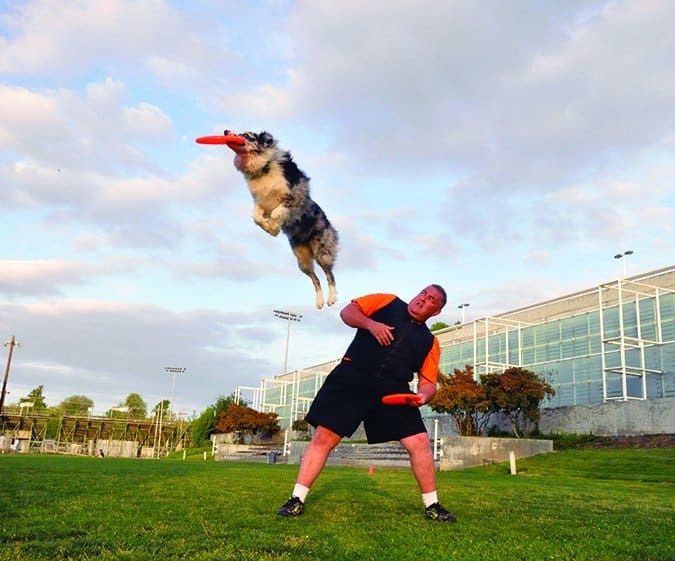HOUSEHOLD DOG AGGRESSION MANAGEMENT: OVERVIEW
1. Manage, manage, manage. Without management, tension between your dogs will likely increase, making modification exponentially more difficult.
2. Eliminate as much stress from your dogs’ lives as possible.
3. Implement an appropriate behavior modification plan to improve your dogs’ relationships with each other.
4. Engage the services of a qualified force-free behavior professional if the aggression is serious, and/or if you have any doubts about your ability to keep everyone safe as you work with your intra-family aggression challenges.

I cringe a little whenever I get a call from a prospective client regarding aggression occurring in the home between their own dogs, but in the past year, I’ve gotten increasingly sensitized to this situation. The number of families who have contacted me for help with intra-family canine aggression has spiked – and this number includes three families who called me because one of their dogs killed another of their dogs. In the prior 21 years Peaceable Paws has been in existence, I had never gotten this call. To have three of them in the span of a few months boggles my mind.
This behavior is sometimes called “intra-pack” aggression. But in recent years we have moved away from the concept of canis lupus familiaris as true pack animal, toward an understanding that a collection of multiple dogs – whether running loose as “street dogs” or cared for in a home – is most commonly a loosely organized social group of unrelated canines, not a real “pack.” Members of your family, yes, for sure. But a true pack, as in a group of closely related canids – mom, dad, and several juveniles who haven’t yet struck out on their own . . . no. Hence my new term, “intra-family aggression.”
Whatever you choose to call it, it’s not fun to live with. Until a few years ago when old age took our 13-year-old Australian Shepherd Missy from us, our life was a constant management challenge. When we first adopted Missy at age eight, our then five-year-old, very assertive Cardigan Corgi Lucy took exception to Missy’s excited greetings when I would come in the back door, and fights would ensue. We managed this by gating Lucy in my office when I went out so I could greet Missy at the door, then greet Lucy once Missy had calmed.
Even prior to Missy joining our family we had already made a habit of giving our dogs high-value chews only when they were safely shut in their crates, and high-value toys only under direct supervision, as Lucy had shown at an early age a strong penchant for fierce resource-guarding. Though our other two dogs defer to Lucy most of the time, we still carefully manage and monitor mealtimes to make sure no one offends her by trying to play musical food bowls.
It can be exhausting to micro-manage the dogs’ every movement – but it’s critical for a peaceful existence in a household with one or more dogs likely to do harm to each other.
You Must Manage Dog-Dog Household Aggression
If you do nothing else about the aggression between your dogs, you must scrupulously manage their movements and activities. Every time your dog successfully engages in a behavior that you don’t want her to exhibit, it makes it that much harder to convince her that it’s not a useful behavior strategy. Every time your dog aggressively communicates to another canine family member, it increases the potential for unresolvable aggression between the two and serious injury to one or both.
In this case, management means using leashes, tethers, baby gates, crates, closed doors, and kennels to control the dogs’ movements and access to each other. Some households even have segregated floors, with Dog A restricted to the first floor, Dog B to the second floor, and Dog C in the basement.
Whatever management tools you choose, it’s important to prevent escalating tension between dogs. If your canine family members are snarling at each other from opposite sides of a baby gate, or one is defensively aggressive because she’s trapped in her crate while her tormentor dances around the outside, it’s not going to help your quest for world peace.
Behavior-altering medications for your dogs might also help. Consultation with a veterinary behaviorist or a behaviorally knowledgeable veterinarian will help determine appropriate medication(s) and purpose – whether to calm the aggressor, reduce stress of the victim, or otherwise alter the mindset and behavior of one or both. Absent access to one of these professionals, your veterinarian can arrange to do a phone-consult with a veterinary behaviorist; many of them offer this service at no charge to other veterinarians.
Management is Critical But Imperfect
You may choose to manage your dogs while you work to improve their relationship with behavior modification, or you may simply choose to manage behavior for the life of one or both dogs. Lifetime management can be a perfectly reasonable choice. Either way, there are a couple of things you need to know.
Some trainers warn their clients that management always fails at some point. I prefer to say management has a high likelihood of failure at some point. If you are considering management as a long-term solution, you need to consider two things: the likelihood of failure to successfully manage your dogs, and the consequence of failure.
There are several conditions that increase the likelihood of management failure:
• Children in the home. From small children to teenagers, children are generally less attentive to and more unreliable regarding ability and willingness to comply with management protocols.
• Non-committed adults in the home. Adults who are not interested in the welfare of the dogs may not pay attention to your management protocols, or worse, if the adults are in any way resentful of or irritated by the dogs, may actively undermine management efforts.
• Lots of visitors. It’s not reasonable to expect visitors to comprehend and comply with your management protocols. If you have frequent visitors, consider things like hasps and padlocks rather than just closed doors. If you rarely have visitors but are having family staying for a week over the holidays, consider boarding for one or more dogs.
• Persistent or particularly strong dog(s). The more dedicated one or more of your dogs is to doing harm to the other, the greater the chance that management will fail. The dog who constantly looks for the opportunity to push through a door, knock down a baby gate, or jump a fence is far more likely to breach management than one who just takes advantage if opportunity presents itself.

What about the consequences of failure to adequately manage your dogs? How you answer this question may suggest how you choose to proceed with your squabbling canines. If there’s just a little (or a lot of) sound and fury but no blood, then management may be a reasonable long-term option. For example, in a home with two dogs of a similar size and weight and good bite inhibition, even if there’s a management glitch, there’s no serious harm done.
At the other end of the spectrum of seriousness, however, is a home where there is a big difference between the size and strength of the dogs, or where one dog exhibits poor bite inhibition – that is, when he bites, he always does serious damage. In cases like this, where a management failure in your family of dogs means that someone will likely end up in the emergency clinic (or worse!), your management has to be scrupulous and infallible, with all family members on board, and you need to make a serious commitment to a behavior modification program that will ease tensions between dogs.
A Sample List of Common Dog Stressors and Strategies
Here are some examples of things that might be on your dog’s list of stressors, and strategies that are most appropriate for each one. There are many other possibilities; my clients’ lists usually contain between 10 and 20 identified stressors. Be sure to include even those things that may cause your dog to be even mildly stressed; the more stressors you can remove, the better.
| STRESSOR | Change dog’s opinion of the stressor with counter-conditioning and desensitization | Teach the dog a new behavioral response using operant conditioning | Manage the dog’s environment to minimize exposure to the stressor | Get rid of the stressor | Live with it (most appropriate for low-level stressors) | Additional solution and/or resource |
| The other dog | ✓ | |||||
| People passing by outside the living room window | ✓ | ✓ |
Block access to windows | |||
| Threats to his resources | ✓ | ✓ | ✓ | |||
| Doorbell ringing | ✓ | ✓ | See, “Unwanted Barking at the Front Door“ | |||
| Car rides | ✓ | ✓ | See, “Driving Safely with Your Dog“ | |||
| Trips to the vet hospital | ✓ | ✓ | See, “Step by Step Training for Your Dog’s Next Vet Visit“ | |||
| Nail trimming | ✓ | ✓ | See, “Force-Free Nail Trimming Techniques for Your Dog“ | |||
| Thunder | ✓ | ✓ | Possible use of appropriate anti-anxiety medication | |||
| Fireworks | ✓ | ✓ | ✓ | Possible use of appropriate anti-anxiety medication | ||
| Arthritis | ✓ | Possible use of pain-reducing medication | ||||
| Recurring ear infections | ✓ | Explore medical treatment and diet – allergies? | ||||
| Underground shock fence and/or shock collar training | ✓ | See, “The Canine Shock Collar Debate“ | ||||
| Prong collar | ✓ | |||||
| Use of physical and/or harsh verbal corrections (punishment) | ✓ | See, “Dog Training Using Positive Techniques“ | ||||
| Owner stress | ✓ | ✓ |
Stress Management & Behavior Modification
Note: Intra-family aggression can be a complex and difficult behavior to manage and modify. For purposes of this article, we are discussing dogs who normally get along reasonably well, and for whom aggression occurs only under certain circumstances. Dogs who consistently and seriously aggress at the mere sight of each other are a whole different challenge, and definitely require the guidance of a qualified force-free behavior professional.
There is actually a wide variety of canine behaviors that behavior experts would describe as “aggression” – or more accurately, “agonistic behavior” – but most dog owners are aware of only the most dramatic ones, such as growling, lunging, snapping, biting, and fighting. More subtle agonistic behaviors such as a freeze, a hard stare, or even a lack of eye contact, may go unnoticed and unaddressed. It’s hugely helpful for an owner to learn to recognize the subtle signs of aggression, perhaps with help from a canine behavior professional, so that management and modification can be put into place well before the aggressive acts result in injury (or worse).
It’s also important for owners to understand that aggression is caused by stress. Dogs who don’t have a worry in the world have no need to behave in an aggressive manner! They use aggressive behaviors to change the conditions that contribute to their stress, in order to reduce that stress.
For example, it’s stressful to be fearful or anxious about the approach of a strange person or dog; a dog may exhibit aggressive behavior in an attempt to put more distance between themselves and the person or dog she perceives as a threat. It’s stressful for some dogs to be concerned about having a toy or chewie taken away, or to worry about losing access to the most comfortable bed or proximity to a favorite human is being threatened; some of those dogs may try to mitigate their stress by aggressively defending their valued commodities.
The more stressors that a dog is subject to, the more at risk he is for behaving aggressively. And because it’s impossible to predict which stressor might push him over his stress threshold into hurting another dog or person – stressor Jenga! – it’s particularly useful to identify as many of his stressors as possible and eliminate as many of them as you can. (For an article that explains stress thresholds in depth, see “Understanding Aggression in Dogs,” October 2010.)
Try to list everything that you can think of that stresses your dog; the list of potential triggers for intra-family aggression is endless. The solution to eliminating each stressor will depend on what it is, but there are five major approaches that can be used on just about any of them; see “A Sample List of Stressors and Strategies” in the table above.
While you are doing that, consider appropriate steps to modify the behavior, depending on what your dogs’ triggers are.
Here are eight of the most common triggers for intra-family aggression, and what you can do to manage and/or modify the behavior:
Trigger 1: Competition for tangible resources – food, treats, toys, etc.
Management: Restrict access to guardable resources. Dole out treats and toys in controlled circumstances (crated, or one-on-one interactions) rather than leaving them lying around or tossing treats indiscriminately. Some dogs are okay if you feed treats directly to each mouth, others may aggress in that situation.
Modification: Use carefully controlled counter-conditioning to convince dogs that the presence of the other dog makes more good stuff happen. Note: This can be tricky with dog-dog resource guarders! (See the resource guarder Counter-Conditioning Procedure below.)
Alternatively, consider a Constructional Aggression Treatment (CAT) procedure, using negative reinforcement (dog’s behavior makes a bad thing go away) to help your dog be relaxed about the presence of another dog near valuable resources. (See Constructional Aggression Treatment, also at the bottom of this page.)
Trigger 2: Competition for attention
Management: Separate dogs during high-competition times such as humans returning, sofa-cuddling time, etc. Be sure to make time to give dogs adequate individual attention.
Modification: Use negative punishment (dog’s behavior makes a good thing go away) when one dog acts inappropriate in response to the approach of the other. Use a neutral or cheerful no-reward marker such as “Oops!” and walk away from the dog who is inappropriate.
Trigger 3: Space-guarding – beds, passageways, kitchen, etc.
Management: Restrict dogs’ movement in guarded areas, making sure only one dog at a time has access.
Modification: Teach a solid “go to place” response so you can send dogs away from each other as needed. Use counter-conditioning or CAT procedure to help dogs be more comfortable in these spaces.
Trigger 4: Social tension – one dog’s perception that another is behaving inappropriately
Management: Identify and avoid situations where one dog is offended by the other dog’s social behavior. These are most often situations where Dog A believes Dog B should defer, and Dog B does not.
Modification: With the aggressor on a leash, counter-condition in the presence of the other dog’s social behavior. Alternatively teach Dog B to perform deference behaviors on cue (lower head, look away) and then cue those behaviors when needed.
Trigger 5: Pain. This may involve actual pain caused by the other dog, pain perceived to have been caused by the other dog, or the anticipation of pain that might be caused by the other dog.
Management: Treat with appropriate pain-relief medication after consultation with vet. Treat as appropriate any medical conditions that cause the dog stress, pain, or discomfort. Prevent physical contact between dogs until condition is under control.
Modification: May need to do counter-conditioning to undo pain-related associations even after pain/discomfort is treated/under control.
Trigger 6: High arousal. Too much excitement can spill over into aggression during play, especially if you have a dog who functions as “fun police.” This is often a herding dog (like my dog Lucy) who has a strong genetic propensity to want things to be under control at all times.
Management: Monitor all interactions between dogs, and interrupt play for a time-out if dogs are getting too aroused. Remove “fun police” dog from play arena so other dogs can play appropriately.
Modification: Interruptions of play is actually a form of negative punishment. Over time, dog(s) may inhibit their own play in order to avoid the time-out.
Trigger 7: Redirected aggression. This is often a result of “fence fighting,” when a dog is being aggressive toward a neighbor dog or a stray on the other side of the fence, and turns on his hapless canine companion, but it can also result from other manifestations of arousal.
Management: Prevent the situations from occurring the lead to this kind of arousal and frustration.
Modification: Teach a “walk away” cue that invites both dogs to quickly and happily move away from the arousing stimulus before they reach the level of aggressing.
Trigger 8: Aging. As a senior dog loses vision, hearing, and mobility, he may become less aware of a younger dog’s signals, and less able to respond quickly.
Management: This is primarily a management situation. You simply must protect your senior dog from the younger dog’s aggression. Keep them safely separated when you are not there to intervene, and when you are there, be very aware of any interactions that could result in aggression, and be prepared to intervene proactively.
Modification: Teach a “walk away” cue that will invite the younger dog to quickly and happily move away from the senior when you see any sign of tension. (The “walk away” behavior is explained in “How to Teach Your Dog to Trade,” in the February 2017 issue.)
Dog-on-Dog Aggression is Overwhelming
I understand if you feel hopeless or overwhelmed – especially if you have been told by other people that you should rehome or euthanize your dog.
In my 20-plus years of practice as a canine training and behavior professional, I have not once told a client that they needed to rehome or euthanize their dog for behavioral reasons. What I do say is this: “Here is what we need to do in order to keep your dog(s) safe, and your family and community safe from your dog(s). I will do everything I can to help you with this. And if, at some point you decide that you are not able or willing to do these things, I will support your decision to rehome or euthanize your dog.”
I then go on to discuss why rehoming is often not a realistic option for a dog with significant behavioral challenges, and that there is a significant risk that the dog could be mistreated in a new home at the hands of an owner or professional who still uses old-fashioned, coercive, pain-causing methods. I have had only a very few clients over the years opt for either of these hard choices; most are remarkably committed to helping their dogs stay in their homes.
Intra-family aggression modification is not for the faint of heart. It often requires the assistance of a knowledgeable, experienced professional to guide the program to success. The more intense the aggression, the more challenging the behavior is to modify. This will be a long-term project, and you must go slowly and manage well. As my trainer friend Gwen Podulka said to me recently, “Think crock pot, not microwave.” However, with excellent management and careful modification, most dogs in this difficult situation can live long and happy lives with their human and canine family members.
Counter-Conditioning Procedure for Dog-Aggressive Dogs
Counter-conditioning and desensitization (CC&D) involves changing your dog’s association with an aversive or arousing stimulus from negative to positive. While the easiest way to give most dogs a positive association is with very high-value, really yummy treats, this presents a significant challenge when dealing with resource guarding. You must very carefully manage the dogs’ proximity to each other as you present the high-value treat. I recommend tethering the guarder (Dog A), and having a second handler approach with Dog B on a leash to prevent him from coming too close to Dog A.
| Here’s how the CC&D process works: |
| Determine the distance at which Dog A can be in the presence of Dog B and be alert or wary but not aggressing or nearly aggressing. This is called the threshold distance. |
| 1. Have Dog B approach to the threshold distance with your handler-helper, and start feeding your high-value treat to Dog A. (I like to use chicken, canned, baked or boiled.) Pause, let Dog A look at Dog B again, feed again. Repeat several times. (Handler can also feed treats to Dog B during this procedure.) |
| 2. Have your handler move Dog B away, and stop feeding Dog A. |
| 3. Keep repeating Steps 1-2 until the approach of Dog B at that distance consistently causes dog A to look at you with a happy “Where’s my chicken” smile on his face. This is a “Conditioned Emotional Response (CER) that tells us Dog A is now associating the approach of Dog B with good stuff, rather than seeing Dog B as a threat to his good stuff. |
| 4. Now you need to increase the intensity of the stimulus by having Dog B come a step closer. When Dog A alerts, feed chicken as in steps 1 and 2. |
| 5. When you have consistent CERs at the new distance, bring Dog B another step closer, and continue. I recommend you put a barrier such as an exercise pen between the dogs, especially when distance decreases to possible contact, in order to avoid an incident if you should misjudge the dog’s behavior. |
The Constructional Aggression Treatment (CAT) Procedure
| The CAT procedure utilizes negative reinforcement to change your dog’s behavior. Here’s how it would work for dog-dog resource guarding: |
| 1. Have one person holding Dog A (the resource guarder) on leash in proximity to a guardable resource, while a second person approaches with Dog B on leash. |
| 2. When Dog A shows any sign of tension, have Dog B stop. Mark that spot. |
| 3. When Dog A relaxes because he realizes Dog A isn’t coming any closer, turn and walk away with Dog B. You just told Dog A that relaxing makes Dog B go away. |
| 4. After a 15-second “breather,” return to with Dog B to your marked spot. Wait for Dog A to relax, and leave. |
| 5. Repeat steps 1-4 until Dog A shows no sign of tension when Dog B arrives at the marked spot. |
| 6. Come one step closer with Dog B, and repeat steps 1-5. |
| 7. Gradually work your way closer with Dog B. Ideally you will start seeing affiliative (come closer) behavior from Dog A, as he becomes more and more relaxed about Dog B’s presence near his valuable object. I recommend you put a barrier such as an exercise pen between the dogs, especially when distance decreases to possible contact, in order to avoid a possible incident should you misjudge the dogs’ behavior. |
For more information on resource guarding and how to deal with it, read “How to Manage Your Resource-Guarding Dog,” (October 2011).
For an in-depth look at CAT, see “Constructional Aggression Treatment (CAT) Can Improve Behavior,” (December 2009).
Author Pat Miller, CBCC-KA, CPDT-KA, is WDJ’s Training Editor. Miller is also the author of many books on positive training. Her newest is, Beware of the Dog: Positive Solutions for Aggressive Behavior in Dogs.


